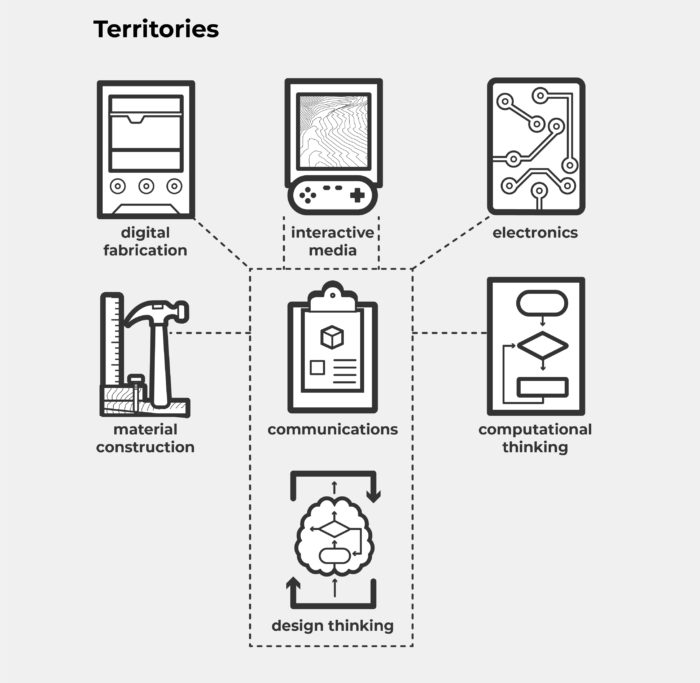Curriculum Territories
The Bit Space curriculum covers seven territories across the spectrum of design and making:
- Design Thinking
- Communication
- Material Construction
- Digital Fabrication
- Electronics
- Computational Thinking (Coming Soon!)
- Interactive Media (Coming Soon!)
It utilizes an interdisciplinary approach and thoughtfully crafted sequences which situate progressive learning beyond just a collection of one-time activities. This set of unique engagements is connected to video-supported training in a variety of tools and techniques. Additionally, the content is referenced to the Common Core State Standards for Math and English Language Arts and the Next Generation Science Standards to help teachers integrate it into coursework.
Structure
The curriculum is divided into two types of content: Elements and Engagements.
Elements are designed to be universal components which act as reusable building blocks to support a variety of Engagements.
- Tools/Materials: things we use
- Concepts: ways of thinking
- Techniques: ways of doing
Engagements are hands-on experiences which employ the Elements in a variety of different ways over different lengths of time.
- Activities are much more focused
in their prompts and constraints and usually are aimed at practicing very specific concepts or techniques. They aren’t projects per se, but some activities might take more than just a few minutes. - Projects use prompts and constraints to move a student towards a particular kind of unique authorship, generally to produce some kind of thing (whether physical or digital). Projects might be completed in a single session, but they typically have a kind of comprehensive significance to them
. Sequences stitch together a series of engagements to deliver a comprehensive design and making education experience.
Implementation
This curriculum is flexible in design so that it may be applied in a variety of ways. Each piece of content can stand on its own to be used by a teacher as they see fit to implement it in their classroom or out-of-school-time programming. Here are a few options:
Use standalone engagements.
If you’re looking for some great projects or activities which you can run to connect your classroom to making, we’ve got them. Pick and choose the engagements which fit your students, timeframes, and objectives.
Follow one (or more) of our sequences.
Each of the territories will offer a progressive sequence, focused on developing those particular territory skills. Additional sequences combine content from across territories to create holistic learning experiences.
Build your own projects.
If you have projects of your own you want to run with students but lack the resources to help get students up to speed with techniques, we have the support network you need. Our Concept and Techniques Elements are the reusable building blocks we utilize to build our Engagements and are written to be as independent as possible. They will connect you to documentation on the tools and materials employed in their implementation. This might be all you need to support the project of your dreams.



